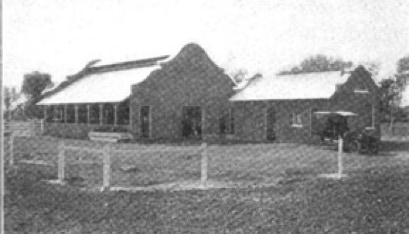Dr. James Collier Norton

Dr. Norton was a son of a prosperous Iowa cattle grower. After finishing first in his class of veterinary medicine, he stayed on as an assistant professor until he moved to Phoenix, opened his practice here. That same year, he married his Iowa sweetheart -- Miss Clara Tufts.
His first office was at 144 W. Washington and he kept his horse and buggy across the street. When he received his appointment as territorial veterinarian in May 1893, they provided 10 cents a mile travel expense for the new official.
Before he retired from this position, he was credited with eradicating the cattle tick in the state. In 1904 he was named national president of the United States Livestock Sanitary Association.
When the doctor arrived in the town, he was dismayed to find that there was no Young Men's Christian Association. Through his efforts, first meetings were held in a rented storeroom. The late William B. Christy, a civil war colonel, was first president. Finally, in 1904, a board was elected and Dr. Norton spearheaded the first YMCA building program fund drive.
His association with the First Presbyterian Church spanned nearly 60 years. For 48 he was chairman of its music committee, served as an elder, and was named a commissioner of the general assembly of the church in 1931.
He also found time to serve as president of the Phoenix Chamber of Commerce in 1916, as president of the Arizona Farm Bureau, and a member of the Phoenix Rotary Club. He aided in efforts to rebuild the Southern Pacific Railroad tracks and managed the project to permanently dike the Salton Sea, whose escape necessitated the rebuilding.

In 1912, he resigned as territorial veterinarian to establish the Norton Dairy. The spacious home was built shortly after for his wife, sons James, Oakley and the late Victor, and his late daughter Marietta.
Mrs. W. W. Pickrell recalls living with the Norton family during 1916 and 1917 when she and Marietta attended college in Tempe. In those days, the two younger boys helped with the dairy and the oldest was a student at Occidental College in Los Angeles.
Excerpted from article in The Arizona Republic, Phoenix, July 30, 1961
The Norton House

The cool green spacious front lawn was a frequent setting for croquet, and to the rear of the home was a large fruit orchard of plum, peach and apricot trees.
One enters the house over a wide porch. Double doors are topped with fan windows of Georgian period. The living room entry had a fireplace of gray stone on the east wall. To the south was a library and north, beyond sliding doors, a roomy dining room.Here the wainscoting, large built-in buffet and beams echo the mahogany woodwork of the other downstairs rooms.Over the buffet, light streams through a leaded glass window highlighted with stained glass sprays of grapes and vines.The same motif is repeated in all paints on the dark beams of the ceiling.
A walk-through pantry and china closets separate dining room and kitchen.Also on the first floor were a Maid’s room and bathe and rear screen porches.
Upstairs were five bedrooms, one of which had its own fireplace, and a large bathroom off a wide center hall. Two screened sleeping porches ran the length of the house across the back.
To the west of the home was a large two-car garage and laundry room. It was roofed in Spanish tile to match the house.
Before Dr. Norton sold his property, the house boasted one of the country’s earliest coolers.This was a large bin effect covered with coke and fiber glass which was kept wet. Electric fans inside drew the dampened air through a basement window into the home.
A June 7, 1934 issue of The Arizona Republic shows figures for the proposed Encanto Park land purchase with labor to be done by the Public Works Administration. The Norton property to be bought by the city was 104 acres at the price of $250 per acre, and the remainder of the property was subdivided into the Del Norte Estates.
Miss Laura Herron, then superintendent of recreation chuckles as she remembers when they finally took over the property in the spring of 1935. The insurance policy was not in effect if the house was empty. So, duty-minded, they took turns spending the night in the huge house. Later the first parks board was organized with Lester Mahoney, local architect, as its chairman.
In the early days of Encanto Park, the recreation department had three rooms. Miss Alvida Hanson operated a branch library from the living room and dining room and caretakers occupied the upstairs. For a time, the preschool classes for hard of hearing sponsored jointly by the Maricopa County Crippled Children's Society and Phoenix Junior League held forth in the garage.
When the Valley Garden Center was first organized in 1939, they were permitted to use the home for the consideration of $1 a year for headquarters, Mrs. Byron Showers, first president, remembers.
Currently the Parks and Recreation Department uses all the rooms of the home for its offices. Cedric Austin, director of the Parks has an office in the dining room. The screened porches have been enclosed for additional space, but otherwise, the Dr. Norton home stands with dignity unchanged. The green lawns and tall trees still border the golf course in Encanto Park west of 15th Avenue.